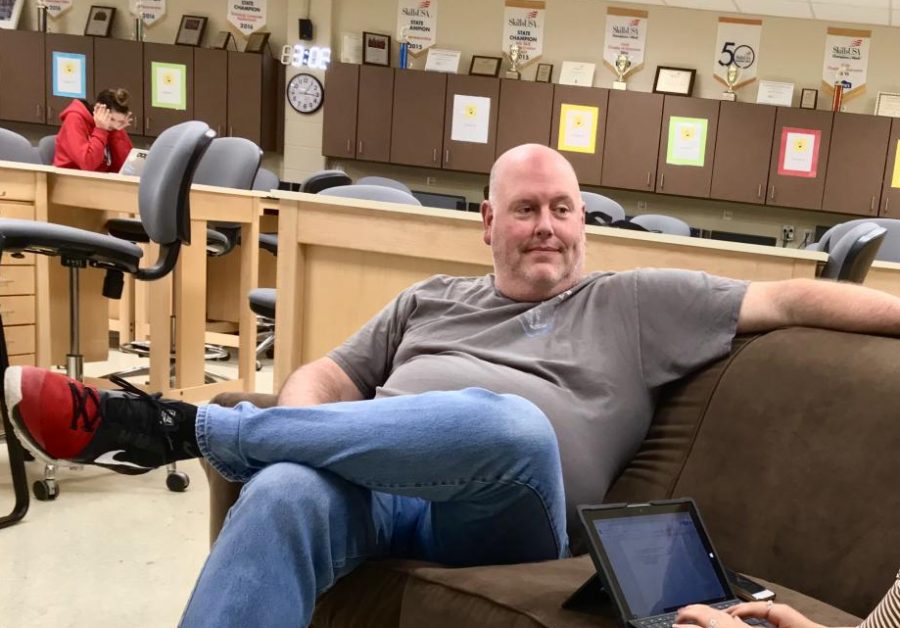Q&A: Law & Justice Teacher Thomas Washburn’s Take on the Lanyard Policy
Law and Justice teacher Thomas Washburn gives an interview on the couch in his room.
January 16, 2019
For many students and staff, the school’s recently implemented lanyard policy has become a point of scrutiny, with many questions up in the air. What is the purpose of the lanyards? Will they really increase school safety? Will they be enforced, and if so, how? To answer these, The Bear Witness sat down with Law & Justice teacher and school safety expert Thomas Washburn to get his professional input on the new policy.
What is your background with school safety specifically?
“So, I was a cop, then I was a school resource officer for five years. I actually wrote Fulton County’s first comprehensive security plan back in 1993”
…
“I’ve been on various county and local school safety committees for the entire time I’ve been in education.”
Do you have experience with safety measures like the lanyards?
“School safety, yes, as a whole. Now, the conversation about lanyards is… many school systems in other states have had these for decades. Some states implemented these back in the ‘90s, so this is nothing new.”
Have you seen a reaction from your students about this policy?
“Yeah, I mean, anything you have to do, there’s a natural human resistance to change. Just having to remember something else is frustrating for students. But I point out ‘you remember your cell phone pretty consistently, so it’s possible to create new habits, to make sure you remember things. And there’s a number of school systems where this is mandatory, so it’s not like we’re some weird school on the edge of nowhere, just coming up with some Draconian measures for the sole purpose of annoying our kids, which of course is the typical Cambridge reaction.”
What are your thoughts on the lanyards?
“I think we should’ve opened the school with them. I don’t know why we didn’t have them to start with. I think, seven years ago, we had the opportunity to start a new culture and we should’ve implemented it then. I don’t understand why schools don’t have it 100%. I mean, it’s just a no-brainer. Every major company on the planet, every major building you go into in America, you have photo IDs, you have checking in and checking out, visitor passes. If you go down Windward Parkway — not the public companies like Starbucks — but the corporations like Newell or Rubbermaid, you can’t get in the door… Any of the telecoms, anywhere around here that’s a company, you need to have an ID. So if anything, at a base level, we’re teaching you how to be prepared for the world of work, right? By just keeping up a lanyard, which is standard practice. On a secondary level, it’s common sense. It’s common sense; there’s no way one teacher knows all 2200 students. There’s no way even the administration knows who’s supposed to be here and who’s not without some physical identification demonstrating who’s supposed to be here.
So you do think they’ll be effective?
“Well, in the simple fact that we’ll be able to regulate who’s supposed to be in the building and who isn’t. There’s been a number of occasions that I’ve run into students on campus from other schools, and because they’re your age and they look like they fit in here, nobody thinks to stop them and ask if they’re supposed to be here. At my last school, we had a situation where there was allegedly a student on campus with a firearm looking for two students that had started as a fight at a party the weekend before, and we don’t know if he was on campus or not, but there was no way for us as a faculty to know if that person was supposed to be there or not. So, the idea that someone would come on campus to do harm is a legitimate issue.”
…
“I think students are trying to contextualize this within the whole school shooting thing. This has nothing to do with school shootings, and the concept of a mass shooter like the Florida shooter. This is just simple security protocol that should’ve been implemented when we opened the school, you know, seven years ago. Every high school in the nation should have IDs. It’s just standard. See, a lot of the students are arguing; this isn’t gonna stop a school shooter. That’s not even really the point. The point is, we don’t know who’s supposed to be here and who’s not. That’s a fundamental security flaw. So, for me to be able to walk down the hall and see “he has an ID and he has an ID” and if you don’t have an ID, I know you’re not supposed to be here. See, the problem is, now, a lot of kids are putting them on their backpacks and putting them under their clothes. That’s just stupid, because you can’t… it needs to be where I can quickly glance at students who are walking down the hall and verify those are students who are supposed to be here.
Will the rule be enforced?
“The problem with enforcement of rules…. Is the infringement that big of a deal? To the student, no, but in the grand scale of a security policy, yes. For a student, they think it’s dumb. “Oh, I just don’t have my ID on.” Well, you’re either going to have students wear their IDs or you’re not. And this is something that if you don’t have 100% compliance, the policy’s useless. Because then, what happens is teachers let kids walk by without IDs on, cause they’re tired of the kids never having them on. So then, the answer to that is how do you discipline it? But it shouldn’t be something you have to enforce — it should just be something that is. For example, do you have to wear clothes to come in the building? It’s just common sense. Everybody walks in the door with clothes on. You’ve covered up what you have to cover up, and you have your lanyard on. It’s just standard. This shouldn’t even be a disciplinary issue, but it’s going to be, because kids are going to forget them. Personally, I feel like every teacher shouldn’t allow a student in the room without an ID on, and then you solve the problem in a matter of a day or two. Will we go that extreme? I don’t know. I don’t let kids in my room without IDs on, because that’s the policy. The thing is, is this a sound policy? Absolutely. Should it be mandatory in every high school in America? Absolutely. Will it stop mass shooters? That’s not the point. This has nothing to do with mass shooters. This is just a standard safety and security policy. And it should be 100% implemented.”

